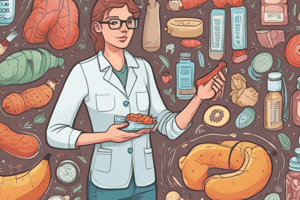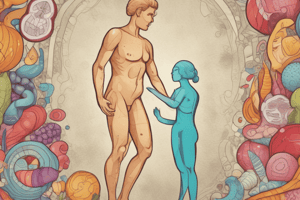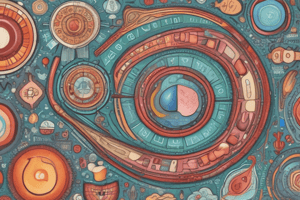Podcast
Questions and Answers
What immediate product is produced when starch is hydrolyzed by amylase?
What immediate product is produced when starch is hydrolyzed by amylase?
- Maltose (correct)
- Glucose
- Lactose
- Glycogen
Salivary amylase remains active in the stomach, where the pH is acidic.
Salivary amylase remains active in the stomach, where the pH is acidic.
False (B)
What is the first step in glucose metabolism?
What is the first step in glucose metabolism?
Glucose is converted to glucose-6-phosphate using ATP.
Glucose combined with ATP is converted to ________ in the first step of the metabolic pathway.
Glucose combined with ATP is converted to ________ in the first step of the metabolic pathway.
Match the enzyme to its source:
Match the enzyme to its source:
What is the primary storage form of carbohydrates in the body?
What is the primary storage form of carbohydrates in the body?
All carbohydrates must be digested to glucose to be utilized by the body.
All carbohydrates must be digested to glucose to be utilized by the body.
Name the two categories of disease states involving carbohydrates.
Name the two categories of disease states involving carbohydrates.
Carbohydrates are compounds containing C, H, and ___.
Carbohydrates are compounds containing C, H, and ___.
What characteristic distinguishes reducing carbohydrates from non-reducing carbohydrates?
What characteristic distinguishes reducing carbohydrates from non-reducing carbohydrates?
Match the following types of carbohydrates with their corresponding number of carbon atoms:
Match the following types of carbohydrates with their corresponding number of carbon atoms:
All carbohydrates are reducing sugars except for sucrose.
All carbohydrates are reducing sugars except for sucrose.
What is the main functional group in aldoses?
What is the main functional group in aldoses?
Name the simplest aldose sugar.
Name the simplest aldose sugar.
Ketoses have their carbonyl group located at the end of the carbon chain.
Ketoses have their carbonyl group located at the end of the carbon chain.
The most common hexose monosaccharides include glucose, galactose, and __________.
The most common hexose monosaccharides include glucose, galactose, and __________.
What aids in the storage of glucose as glycogen in the body?
What aids in the storage of glucose as glycogen in the body?
Match the following sugar classifications with their definitions:
Match the following sugar classifications with their definitions:
In which projection does the hydroxyl group at the anomeric carbon (C1) appear below the plane?
In which projection does the hydroxyl group at the anomeric carbon (C1) appear below the plane?
Ribose is an example of a hexose monosaccharide.
Ribose is an example of a hexose monosaccharide.
What is the primary source of energy for humans?
What is the primary source of energy for humans?
Which hormone is primarily responsible for increasing blood glucose levels?
Which hormone is primarily responsible for increasing blood glucose levels?
Epinephrine decreases blood glucose levels during times of stress.
Epinephrine decreases blood glucose levels during times of stress.
Which hormone decreases intestinal entry of glucose into cells?
Which hormone decreases intestinal entry of glucose into cells?
Growth hormone increases blood glucose by decreasing the entry of glucose into the ______.
Growth hormone increases blood glucose by decreasing the entry of glucose into the ______.
Which hormone enhances the release of cortisol?
Which hormone enhances the release of cortisol?
Match the hormones with their primary functions:
Match the hormones with their primary functions:
Thyroxine (T4) helps increase plasma glucose levels by reducing gluconeogenesis.
Thyroxine (T4) helps increase plasma glucose levels by reducing gluconeogenesis.
What is the main function of human placental lactogen during pregnancy?
What is the main function of human placental lactogen during pregnancy?
Which of the following statements about Type 1 Diabetes is true?
Which of the following statements about Type 1 Diabetes is true?
Testing for diabetes should begin at age 35 for all individuals.
Testing for diabetes should begin at age 35 for all individuals.
Name one autoantibody associated with Type 1 Diabetes.
Name one autoantibody associated with Type 1 Diabetes.
Individuals with a body mass index (BMI) of _____ kg/m2 or greater should be considered for diabetes screening.
Individuals with a body mass index (BMI) of _____ kg/m2 or greater should be considered for diabetes screening.
Match the following risk factors with their descriptions for screening diabetes:
Match the following risk factors with their descriptions for screening diabetes:
Which of the following statements best describes Type 2 Diabetes?
Which of the following statements best describes Type 2 Diabetes?
Individuals with Type 2 Diabetes are typically ketosis prone.
Individuals with Type 2 Diabetes are typically ketosis prone.
Name one common complication associated with Diabetes Mellitus.
Name one common complication associated with Diabetes Mellitus.
Type 2 Diabetes is primarily characterized by __________ resistance.
Type 2 Diabetes is primarily characterized by __________ resistance.
What is a recommended test for monitoring long-term complications of Diabetes Mellitus?
What is a recommended test for monitoring long-term complications of Diabetes Mellitus?
Match the following terms with their correct descriptions:
Match the following terms with their correct descriptions:
Gestational Diabetes Mellitus typically resolves after pregnancy.
Gestational Diabetes Mellitus typically resolves after pregnancy.
In a patient with diabetes mellitus, increased glucose levels in __________ can indicate hyperglycemia.
In a patient with diabetes mellitus, increased glucose levels in __________ can indicate hyperglycemia.
Flashcards
Monosaccharide
Monosaccharide
A simple sugar that cannot be broken down into a simpler sugar by hydrolysis.
Reducing Sugar
Reducing Sugar
Carbohydrate that contains an active ketone or aldehyde group that can reduce other compounds.
Non-reducing Sugar
Non-reducing Sugar
Carbohydrate that lacks an active ketone or aldehyde group, thus cannot reduce compounds.
Glucose
Glucose
Signup and view all the flashcards
Sucrose
Sucrose
Signup and view all the flashcards
Fischer Projection
Fischer Projection
Signup and view all the flashcards
Haworth Projection
Haworth Projection
Signup and view all the flashcards
Stereoisomers (D/L)
Stereoisomers (D/L)
Signup and view all the flashcards
Carbohydrate Classification
Carbohydrate Classification
Signup and view all the flashcards
Carbohydrate Function
Carbohydrate Function
Signup and view all the flashcards
Aldose vs. Ketose
Aldose vs. Ketose
Signup and view all the flashcards
Carbohydrate Formula
Carbohydrate Formula
Signup and view all the flashcards
Types of Diabetes
Types of Diabetes
Signup and view all the flashcards
Starch digestion products
Starch digestion products
Signup and view all the flashcards
Glucose metabolism pathways
Glucose metabolism pathways
Signup and view all the flashcards
Amylase function
Amylase function
Signup and view all the flashcards
Glucose-6-phosphate formation
Glucose-6-phosphate formation
Signup and view all the flashcards
Hormonal glucose regulation
Hormonal glucose regulation
Signup and view all the flashcards
Autoantibodies in Type 1 Diabetes
Autoantibodies in Type 1 Diabetes
Signup and view all the flashcards
Screening for Diabetes in Adults
Screening for Diabetes in Adults
Signup and view all the flashcards
Prediabetes Screening
Prediabetes Screening
Signup and view all the flashcards
Lifelong Diabetes Testing
Lifelong Diabetes Testing
Signup and view all the flashcards
Insulin
Insulin
Signup and view all the flashcards
Glucagon
Glucagon
Signup and view all the flashcards
Epinephrine (Adrenaline)
Epinephrine (Adrenaline)
Signup and view all the flashcards
Cortisol
Cortisol
Signup and view all the flashcards
Growth Hormone
Growth Hormone
Signup and view all the flashcards
Thyroxine (T4)
Thyroxine (T4)
Signup and view all the flashcards
Somatostatin
Somatostatin
Signup and view all the flashcards
ACTH (Adrenocorticotropic Hormone)
ACTH (Adrenocorticotropic Hormone)
Signup and view all the flashcards
Type 2 Diabetes Complications
Type 2 Diabetes Complications
Signup and view all the flashcards
What is a key difference between Type 1 and Type 2 diabetes?
What is a key difference between Type 1 and Type 2 diabetes?
Signup and view all the flashcards
Gestational Diabetes
Gestational Diabetes
Signup and view all the flashcards
What are signs of hyperglycemia?
What are signs of hyperglycemia?
Signup and view all the flashcards
How is diabetes insipidus different from SIADH?
How is diabetes insipidus different from SIADH?
Signup and view all the flashcards
What tests are helpful for monitoring long-term diabetes complications?
What tests are helpful for monitoring long-term diabetes complications?
Signup and view all the flashcards
What are some regular tests recommended for people with diabetes?
What are some regular tests recommended for people with diabetes?
Signup and view all the flashcards
Study Notes
Carbohydrates Objectives
- Students will be able to classify carbohydrates into groups.
- Students will be able to discuss the metabolism of carbohydrates in the body, including the hormones involved.
- Students will be able to differentiate between different types of diabetes based on clinical and laboratory findings according to the ADA.
Carbohydrates
- Carbohydrates are a major food source for energy, primarily stored in the liver and muscle as glycogen.
- Diseases related to carbohydrates are classified into hyperglycemia and hypoglycemia.
- Carbohydrates are derivatives of aldehyde or ketone, based on the location of the carboxyl group.
- Carbohydrates are composed of monosaccharides, disaccharides, oligosaccharides, and polysaccharides.
Carbohydrates-Glucose
- Glucose is the only carbohydrate directly used for energy and stored as glycogen with the help of insulin.
- All sugar molecules must be digested into glucose, a monosaccharide.
General Description of Carbohydrates
- Carbohydrates are compounds containing carbon (C), hydrogen (H), and oxygen (O).
- The general formula for carbohydrates is Cx(H2O)y.
- All carbohydrates contain C=O and -OH functional groups.
- The classification of carbohydrates is based on four structural properties: the size of the base carbon chain, the location of the CO function group, the number of sugar units, and the stereochemistry.
Carbohydrate Classification
- Carbohydrates can be grouped based on the number of carbons in the molecule (e.g., trioses, tetroses, pentoses, hexoses).
- Glucose and fructose are examples of hexoses.
Carbohydrate Stereochemistry
- Mirror image forms (D and L) are based on the position of the -OH group on the chiral carbon.
- D-sugars have the -OH group on the right side of the chiral carbon.
- L-sugars have the -OH group on the left side of the chiral carbon.
Chemical Properties of Carbohydrates
- Some carbohydrates act as reducing agents—these can reduce other compounds.
- Non-reducing carbohydrates lack the aldehyde or ketone group.
Classification based on number of units
- Monosaccharides
- Disaccharides
- Oligosaccharides
- Polysaccharides
Monosaccharides
- Simple sugars that cannot be further hydrolyzed.
- May contain three to six carbons.
- Common examples include glucose, fructose, and galactose.
Glucose
- The primary energy source for humans.
- Central to carbohydrate metabolism.
Fructose
- Also known as fruit sugar
- Component of sucrose.
Galactose
- Glucose precursor, converted into glucose for bodily functions.
- Galactosemia is a deficiency in processing galactose.
Others (Ribose and Deoxyribose)
- Important pentose sugars.
Question 1
- Glucose is the only monosaccharide directly used by cells for energy.
Question 2
- Hydrolysis of lactose by lactase yields glucose and galactose.
Question 3
- Starch is hydrolyzed by amylase to produce maltose.
Glucose Metabolism
- Glucose is absorbed and can enter three metabolic pathways.
- The ultimate goal is conversion of glucose to CO2 and H20.
Hormone Regulation
- Hormones regulate the entry and fate of glucose within the body.
Pancreas
- Two functionally different tissue types exist:
- Endocrine (hormone-releasing): Includes the islets of Langerhans containing four cell types releasing insulin, glucagon, gastrin, somatostatin.
- Exocrine (enzyme-secreting)
Pancreatic Disorders
- Major diseases include diabetes mellitus (DM), islet cell tumors, acute/chronic pancreatitis, pancreatic cancer, and cystic fibrosis.
Hormones Regulating Glucose Metabolism
- Glucagon
- ACTH (Adrenocorticotropic hormone)
- Growth Hormone
- Cortisol
- Human Placental Lactogen
- Epinephrine (adrenaline)
- Thyroxine (T4)
- Insulin
- Somatostatin
Insulin
- Primary hormone for glucose entry into cells.
- Synthesized by Beta cells of the islets of Langerhans.
Glucagon
- Primarily responsible for increasing blood glucose.
- Synthesized by alpha cells of the islets of Langerhans.
Epinephrine
- Produced by the adrenal medulla, increases bloodglucose during stress.
Cortisol
- Produced by the adrenal cortex. Increases blood glucose through mechanisms including gluconeogenesis and lipolysis.
Growth Hormone
- Produced by the anterior pituitary gland, increases blood glucose.
Thyroxine (T4)
- Produced by the thyroid gland, increases blood glucose.
Somatostatin
- Acts like insulin, inhibits insulin, glucagon, and growth hormone.
ACTH
- Enhances cortisol release and fatty acid release, promotes gluconeogenesis.
Human Placental Lactogen
- Increases during pregnancy, and functions to increase gluconeogenesis, and promote insulin resistance.
Hyperglycemia
- An increase in blood glucose concentration that is toxic to beta cells.
Characteristics of uncontrolled hyperglycemia
- Polyuria, ketonuria and glycosuria are seen in uncontrolled hyperglycemia.
Diabetes Classification
- Type I (insulin deficiency): Typically autoimmune-mediated.
- Type II (insulin resistance): More common and often related to lifestyle and genetics.
- Gestational: Develops during pregnancy.
- Other specific types: caused by other factors.
Risk Factors for Diabetes
- Obesity
- Family history
- History of Gestational diabetes (GDM)
- High-risk race/ethnicity
- Hypertension
- Low HDL cholesterol
- Elevated triglycerides
Metabolic Syndrome
- Collection of factors related to increased risk for diabetes and heart disease.
Type 2 Diabetes Classification
- Prediabetes
- Diabetes
Complications of Diabetes Mellitus
- Nephropathy (Kidney disease)
- Neuropathy (nerve damage)
- Retinopathy (eye disease)
- Cardiovascular disease
Laboratory Findings in Hyperglycemia
- Increased glucose in plasma and urine
- Presence of ketones in serum and urine
- Decreased blood and urine pH (acidosis)
- Electrolyte imbalance
Diabetes Insipidus (DI)
- Serum osmolality decreases.
- Urine osmolality decreases.
SIADH (Syndrome of Inappropriate Antidiuretic Hormone)
- Serum osmolality decreases
- Urine osmolality increases
Tests for Long-term Diabetes Complications
- Serum BUN (Blood Urea Nitrogen)
- Serum creatinine
- Urine albumin
- Lipids
Recommended Tests for Diabetes (Annually)
- Blood glucose
- HbA1c
- Microalbumin
- Estimated Glomerular Filtration Rate (eGFR)
- POCT
Gestational Diabetes Mellitus (GDM)
- Diabetes onset during pregnancy due to metabolic and hormonal changes.
- Usually resolves after pregnancy but increases risk of later-onset Type 2 diabetes.
Gestational Diabetes Mellitus Characteristics
- Insulin resistance, decreased insulin secretion.
- Higher prevalence among obese women, older women, those with previous GDM, and certain ethnic groups.
Hypoglycemia
- Imbalance between glucose production and utilization.
- Can be life-threatening if glucose levels fall to dangerously low levels.
Fasting Hypoglycemia
- Hypoglycemia occurring after fasting
- May be caused by tumors (insulinomas), hepatic dysfunction, glucocorticoid deficiency, or sepsis
Lactose intolerance
- A marked decrease in intestinal lactase leads to impaired lactose hydrolysis..
- The buildup of lactose leads to discomfort, cramping and diarrhea.
Galactosemia
- Defects in galactose metabolism result in elevated galactose (in plasma).
- A serious complication, requiring a diet restricted of galactose.
Glycogen Storage Diseases
- Inherited disorders related to glycogen metabolism.
Diagnostic tests for Glucose Metabolic Alterations
- Fasting Blood Sugar (FBS)
- Postprandial Blood Sugar (2 hours after meal)
- Oral glucose tolerance test(OGTT)
- HbA1c
- POCT
- Ketone tests
- Microalbuminuria
- Glycomarkblood Test
- Fructosamine Assay
- C-Peptide test
Studying That Suits You
Use AI to generate personalized quizzes and flashcards to suit your learning preferences.




